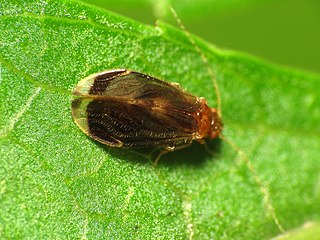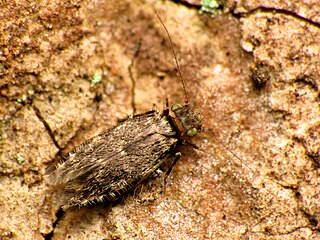
Psocoptera are a paraphyletic group of insects that are commonly known as booklice, barklice or barkflies. The name Psocoptera has been replaced with Psocodea in recent literature, with the inclusion of the former order Phthiraptera into Psocodea.
A pseudo-penis is any structure found on an animal that, while superficially appearing to be a penis, is derived from a different developmental path.

Psocomorpha is a suborder of barklice, booklice, and parasitic lice in the order Psocodea. There are more than 20 families and 5,300 described species in Psocomorpha.

Trogiomorpha is one of the three major suborders of barklice, booklice, and parasitic lice in the order Psocodea, alongside Troctomorpha and Psocomorpha. There are about 8 families and more than 430 described species in Trogiomorpha. Trogiomorpha is widely agreed to be the earliest diverging of the three suborders, and retains the most primitive characteristics.

Troctomorpha is one of the three major suborders of Psocodea (barklice, booklice, and parasitic lice), alongside Psocomorpha and Trogiomorpha. There are more than 30 families and 5,800 described species in Troctomorpha. The order includes parasitic lice, which are most closely related to the booklice family Liposcelididae.

Amphipsocidae is a family of hairy-winged barklice in the order Psocodea. Most species are 3.0-4.5 mm long and have many setae (hairs) on the veins and margin of the forewing. The main veins of the forewing are usually lined with two rows of setae. Like the other members of the infra-order Caeciliusetae, they have a broad, flat labrum, with well defined edges.
Asiopsocidae is a family of Psocodea belonging to the infraorder Caeciliusetae. The family is composed of 14 known species of barklice in three genera: Asiopsocus, Notiopsocus, and Pronotiopsocus. One species from each genus has been found in the United States.

Ectopsocidae is a family of Psocodea belonging to the suborder Psocomorpha. The family includes fewer than 200 species, most of them in the genus Ectopsocus.

Lachesillidae is a family of Psocodea belonging to the suborder Psocomorpha. Members of the family are characterized by a rounded, free areola postica in their wings. Males have diverse sclerotized genitalic structures. The family includes more than 400 species, most of them in the genus Lachesilla.

Hemipsocidae is an insect family of Psocodea belonging to the infraorder Psocetae. Members of the family have the areola postica joined to the M vein by a crossvein, and their M vein is two-branched. This family comprises twenty-four species in three genera: Anopistoscena, Hemipsocus, and Metahemipsocus. They are commonly known as leaf litter barklice.

Homilopscocidea is an infraorder of Psocodea. It is probably a paraphyletic group, still in use for lack of a better solution. There are about 7 families and more than 1,200 described species in Homilopsocidea.

A penis is a male sex organ that is used to inseminate female or hermaphrodite animals during copulation. Such organs occur in both vertebrates and invertebrates, including humans, but not in all male animals.
Prionoglarididae is a family of the order Psocodea that are barklice characterized by the reduction or simplification of the lacinia in adults and the specialised form of the male genitalia. It contains the only known genus of animals, Neotrogla, where females possess a penis-like organ and take on typical male sex roles.

Trichadenotecnum is a genus of insects in the order Psocoptera, the booklice, barklice, and bookflies. It is one of the largest genera, including over 200 described species.

Lepidopsocidae are an insect family of bark lice belonging to the suborder Trogiomorpha. Colloquially, Lepidopsocidae are referred to as the Scaly-winged Barklice. There are more than 220 species described worldwide. Phylogenetic DNA analysis of relationships between families in Trogiomorpha propose that Lepidopsocidae is monophyletic, meaning that the taxa within all share a common ancestor. This is supported morphologically by the presence of scales and setae covering the body and forewings of Lepodopsocids. Sister families of Lepidoposcidae include Trogiidae and Psoquillidae.

Epipsocetae is an infraorder of psocids in the order Psocodea. There are about 5 families and more than 480 described species in Epipsocetae.

Ptyctini is a tribe of common barklice in the family Psocidae. There are about 6 genera and at least 20 described species in Ptyctini.

Psocinae is a subfamily of common barklice in the family Psocidae. There are about 11 genera and at least 40 described species in Psocinae.
Afrotrogla is an African genus of large-winged psocids in the family Prionoglarididae, discovered and described by Charles Lienhard. There are three described species in Afrotrogla, all found in certain caves of Namibia.
Speleopsocus is a genus of psocids (booklice) in the family Prionoglarididae from the Tepui of Venezuela. It is monotypic, containing only one species, Speleopsocus chimanta.














